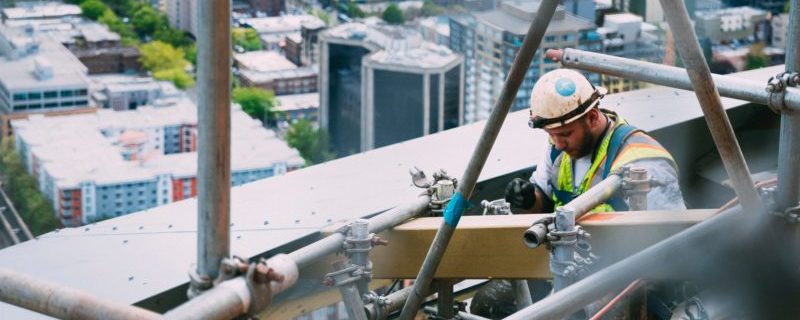_________________________________________________________________________________________________________
Asbestos has been banned in the UK since 1999 and across the EU since 2005. However, there is a huge legacy problem of asbestos in existing buildings. Before it was banned, asbestos was widely used for its positive qualities – it has high tensile strength, flexible fibers, it is stable at high temperatures, it is resistant to chemicals, it has good electrical, sound and heat insulation properties, and it was abundant and available at low cost.
However, after decades of use authorities found that asbestos can be lethal if its fibres are inhaled, which can cause mesothelioma, lung cancer, asbestosis and pleural thickening in individuals who are exposed. In many cases, illnesses that result from asbestos exposure only began to emerge forty years or more after the fact. All of these issues are life-changing, and ultimately, most result in early death. No one would take a risk with asbestos exposure if they really understood the consequences.
_________________________________________________________________________________________________________
Asbestos Exposure Today
 Despite the risks, and despite campaigns by national and international safety bodies, people continue to be exposed. The World Health Organisation (WHO) estimates that each year up to 125 million people in the world are exposed to asbestos in the workplace. In the UK, the Health and Safety Executive (HSE) estimates that around 5,000 workers (or former workers) die every year from asbestos-related cancer. Some of these are the result of historical exposure, before the ban. However, the deaths were expected to plateau once the ban was in place – they haven’t – and people continue to be exposed during refurbishment, demolition or maintenance work.
Despite the risks, and despite campaigns by national and international safety bodies, people continue to be exposed. The World Health Organisation (WHO) estimates that each year up to 125 million people in the world are exposed to asbestos in the workplace. In the UK, the Health and Safety Executive (HSE) estimates that around 5,000 workers (or former workers) die every year from asbestos-related cancer. Some of these are the result of historical exposure, before the ban. However, the deaths were expected to plateau once the ban was in place – they haven’t – and people continue to be exposed during refurbishment, demolition or maintenance work.
It’s not just traditional tradespeople who are exposed – the National Union of Teachers estimate that every year 17 teachers (or former teachers) die from mesothelioma, caused by asbestos exposure in schools.
_________________________________________________________________________________________________________
Prosecutions for Asbestos Exposure
Prosecutions for companies whose employees have potentially been exposed to asbestos are still quite common. In 2017 a construction company was fined £750,000 for poor practice during a demolition and refurbishment project, which could have placed as many as 200 people at risk of asbestos exposure.
In other cases individual supervisors, managers and directors have received community service orders, suspended jail terms or have been disqualified as directors for not ensuring that workers are protected from asbestos exposure. In a more recent prosecution, workers were found to have actually cut previously removed asbestos panels to fill in gaps in a damaged wall. Although their employer had an asbestos survey and action plan in place, employee health and safety training did not cover the measures required to manage the risks of asbestos. In many prosecutions, asbestos surveys have been done, but people carrying out the work, and even their supervisors, did not have sufficient asbestos awareness training to know to ask to see the survey, or to be able to interpret the survey if shown it.
For every prosecution that comes to light, there are many more examples which get brushed under the carpet (literally in some cases). In most cases, a lack of asbestos awareness or health and safety training amongst workers and supervisors is a factor. In a survey of 500 construction workers commissioned by IOSH (the Institute for Occupational Safety and Health) almost one in five said that if they discovered asbestos, they wouldn’t know what to do next, and one third admitted to never checking the asbestos register before they start work. There is clearly a big gap between the asbestos awareness needed and the health and safety training provided in practice.
_________________________________________________________________________________________________________
What Can Employers Do to Prevent Asbestos Exposure?
So how do you make sure that your staff are not in the 33% who don’t check the asbestos register, or in the 20% who don’t know what to do if they suspected it? Or the perhaps larger number of people who, even with asbestos awareness training, wouldn’t know what to look for. Follow these three steps.
1) Survey – The safest approach is to get a UKAS-accredited organisation to carry out an asbestos survey. If you are in a structure built since 1999, you might have evidence that there is no asbestos – but be aware that a new building on a brownfield site could have asbestos rubble buried in the foundations or the grounds. It is important to remember that Asbestos does not rot. Your alternative to a survey is to assume that anything that could be an asbestos-containing material (ACM) is. That would make even the simplest repair job – hanging a clock on a wall, fitting a shelf – a task that could lead to asbestos exposure, so better to know where the asbestos is, and share the information with all employees and contractors who could be affected.
2) Plan – Your survey will help you to write a plan explaining how you are going to manage the asbestos. A duty holder should be named, along with people responsible for asbestos management at each location. Decisions about asbestos management should be risk-based. Asbestos in poor condition, in a location where it could easily be damaged, and where people will be exposed if it is damaged should be checked more often and prioritised for removal or remediation. Asbestos in good condition that won’t be disturbed can be documented in your register, labelled, left in place and inspected regularly.
3) Training – Asbestos awareness training includes both company-specific information and general information about asbestos.
The asbestos action plan and survey should be available to everyone who might need to see it. This doesn’t mean uploading documents to your Intranet and hoping people will go and look at them. Do you have a way of recording that the documents have been sent to all relevant staff? Have they had the opportunity to read it and ask questions about it? And that they have agreed to work within it?
_________________________________________________________________________________________________________
Asbestos Awareness and the Workforce
Plumbers, electricians, fitters, installers, decorators and plasterers, as well as more obvious trades such as demolition workers and roofing contractors, are all at risk of exposure if they don’t know where asbestos might be found, or don’t understand the consequences of exposure. They need to understand why they should ask to see the asbestos register, and be able to interpret the register to plan their work safely – or refuse to work where that is not possible. Making them aware of the uses of asbestos relevant to their work is an essential part of protecting them.
Do they know asbestos was used in the cement for pebbledash finishes, and even in vinyl wallpaper? Your workers might come across something that worries them that wasn’t in the survey. It’s important to remember that asbestos awareness training does not provide people with the competence to work with or remove asbestos, but it is vital for any workers who could be exposed to it during their work.
L143, the HSE code of practice for asbestos management, reminds employers that asbestos awareness training needs to be regularly refreshed, and that e-learning is an effective means of achieving this. If the HSE knock on your door, you need to be able to prove that all relevant workers have received asbestos awareness training, so make sure however you provide the training, it is recorded and assessed.
_________________________________________________________________________________________________________
Conclusion
If your employees or contractors carry out tasks that could disturb asbestos, make sure your health and safety regime will ensure they are not in the one third who don’t look at the asbestos survey, or in the one fifth who wouldn’t know what to do if there was an emergency that involved possible asbestos exposure. By establishing a clear and dedicated approach to asbestos awareness in the workplace, you can help safeguard your workers and the public at large from potential risk.
_________________________________________________________________________________________________________
Are you a SME or Enterprise looking for train your staff in Asbestos Awarness? Visit our eLearning library and try any course for free.
This article is purely for informational purposes. For more information regarding Asbestos Exposure in the UK visit:http://www.hse.gov.uk/



























 where the non-compliance issues arise.
where the non-compliance issues arise.